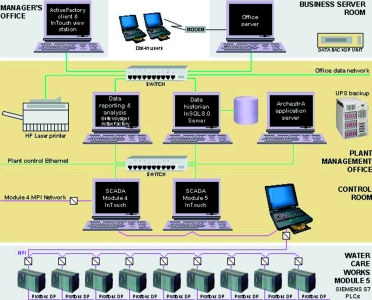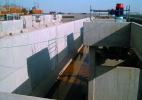
Sebokeng and Evaton are two previously-disadvantaged, sprawling residential areas located in the Emfuleni Local Municipality (Sedibeng District Municipality), which is serviced by Metsi-a-Lekoa, the water and sanitation business unit of the same municipality. These areas support a population of 420 000 and consist of approximately 65 000 freestanding housing units in the Vaal Triangle near Vereeniging.
In 2000, Ram-Tec Systems successfully completed a major upgrade, known to Sebokeng Water Care Works as Module 4. In 2004, the company was asked to implement the addition to the control system for the new Module 5, which is a 35 Ml/day biological nutrient removal activated sludge unit. The contract for the supply, delivery, installation and configuration of the software for the PLC and scada control system was awarded to Ram-Tec Systems by Consulting Engineers, Lyon and Partners while the Emfuleni Local Municipality was responsible for implementing the system.
System overview
The Module 5 extension included a new inlet works, primary sedimentation words, reactor basin, thickener pump station, screenings facility, clarifiers, chlorination system and a new power monitoring system.
One of the key system requirements was that the treatment of effluent needed to continue uninterrupted even in the event of a catastrophic failure of the control system. Another requirement was to keep Module 4 fully functional while the new system was being commissioned.
A distributed control system was installed consisting of eight HMI terminals on a Profibus network for local operational control of each separate process (see Figure).

An MPI fibre-optic network was installed as the common network between all existing and new PLCs as well as for the connection to the main scada system. Fibre-optic cables were chosen to protect against hostile environmental conditions such as lightning while providing error-free communication over long distances. Self-diagnostics on the OLM fibre-optic converters at each PLC made the testing and setting up of the network simple and quick.
All the PLCs are connected to two InTouch scada stations, which are located in a central control room. The scada system is running on an ArchestrA platform with a separate InSQL Server, a separate reporting machine and a separate galaxy repository. ActiveFactory is used as the primary analysis tool and can be accessed remotely if required. The plant manager is running an InTouch view node from his office. The existing Module 4 was incorporated into the system thereby providing an effective way of monitoring the entire plant, which is spread over a large geographic area.
Motor control centres (MCCs) and electricity consumption monitoring
In the MCCs, various combinations of Siemens Simocodes and VSDs were installed which share the same Profibus network as the OP27. Additionally, a Siemens ET200S motor start system was installed in the field to control a custom-designed oxygen utilisation rate sampler for the aerator basin. The ET200S communicates with the chlorination PLC via Profibus communications.
Some of the PLCs also have Profibus DP field instruments connected to them, namely Endress+Hauser flowmeters, suspended solids meters, dissolved oxygen meters and level transmitters. The primary sedimentation tank's screens and the screenings facility also have Endress+Hauser level transmitters running on Profibus DP/PA.

Each MCC also has either one or two (depending if there are separate essential and non essential services) Socomecs on the Profibus network. The Socomec provides energy consumption information such as voltage, current, power, power factor, etc. This information is displayed on the scada systems and helps to determine the electricity costs. The main incoming substation has Socomecs on each of the feeders, which communicate to a dedicated S7-300, which shares the same network as the other PLCs.
Overcoming the challenges
The entire Module 4 and Module 5 control system was developed in the allocated project period in spite of some difficulties.
"The distributed nature of the plant over a sizeable geographical area presented unique challenges," says Paulo De Sousa Gomes, engineering director, Ram-Tec Systems. "Hence the use of fibre-optic cables for reliable communications. And in these circumstances, it is also often easier to revert to the traditional thinking of individual modules and lose sight of the fact that they are all part of the same facility and should be treated as such. To this degree, ArchestrA's 'galaxy' and single namespace concept, helped to pull it all together. Another approach which was of great help was the ability to use the technology available in the field instruments to assist with diagnostics and fault finding. Today, with the development of open networks and standard industrial protocols it is easier to totally integrate different supplier platforms."
Another challenge was the management of the large amount of information supplied by the intelligent devices on the network. "While information is always welcome," adds De Sousa, "it can be overwhelming if it is not filtered and collated into a form that makes sense to the person that has to act on it."
With its comprehensive realtime reporting facilities, plant-wide centralised control, easy access to operational information and defined standards, the Sebokeng Water Care Works control system is geared for fast and cost-effective expansion as well as efficient operation.
Project summary:
* Client: Sebokeng Water Care Works
* Project goal: Increase sewage effluent treatment capacity from 65 Ml/day to 100 Ml/day.
* How to get there: Upgrade the existing scada facilities to the latest technology while adding and automating a new treatment module. All this while looking after existing assets, making provision for control over a large geographical area and making provision for cost-effective future growth.
* Selected solutions: Siemens S7-315 PLCs, Wonderware's InTouch HMI/scada running on the ArchestrA platform, IndustrialSQL Server (InSQL) realtime historian, SuiteVoyager web portal and ActiveFactory reporting and analysis tool.
* Derived benefits: Sebokeng Water Care Works now has a truly expandable level 0 to 3 control system. The use of the engineering standards developed in this phase of the project will speed the implementation of future plants. Other benefits include:
* All the information required for analysis and mandatory reporting is available through the InSQL historian.
* Users can access plant-wide data from their offices using a WAN of dial-in network.
* The availability of the ActiveFactory trending function as well as power consumption figures within the scada application provides operators with important realtime decision-support information.
* System Integrator: Ram-Tec Systems.
* Project owners: Emfuleni Local Municipality.
Transforming sewage into potable water
Inlet works
Raw sewage from Sebokeng and the neighbouring urban areas enters the plant at the inlet works. A set of inlet screens removes non-biodegradable and large solids from the raw sewage. The overflow is fed to the degritters, which remove sand and silt particles from the sewage before it is passed on to the primary sedimentation works. The PLC's main function is to monitor the screen differential level flow and activate the cleaning cycle accordingly. The degritters are started on a timing cycle dependent on the inflow.
Primary sedimentation works
The flow from the inlet works is fed to the primary settling tank where biodegradable solids are separated from the liquid waste. The solids precipitate to form sludge, which is recycled until it is adequately dissolved for further downstream processing.
Reactor/aerator basin
The reactor/aerator basin is the major sewage processing plant and comprises of a mixer and two aerator sections. In the mixer stage, anaerobic microorganisms digest suspended waste material and turn it into inert by-products. In the aerator stages, the oxygen content is increased to allow aerobic digestion of waste matter. At the end of this stage, the water has effectively been cleaned of waste matter. The aerator motors are controlled by Simocodes according to the oxygen utilisation rate, which is monitored by the PLC. Controlling the dosing pump VSDs according to the inflow rate also regulates ferric chloride dosing.
Clarifiers
Although the reactor output to the clarifiers is largely clean water, it does contain some particulate matter as well as flocculants. The particulate matter sinks to the bottom of the clarifier to form what is referred to as waste activated sludge (WAS). Return pumps send the WAS back to the reactor/basin for further processing. The clean water flows through to the chlorination system. The PLC controls the return pump speed via VSDs in proportion to the inflow of the reactor.
The chlorination system
The final step of the process is to dose the water with chlorine to remove remaining bacteria and to expose it to sunlight in maturation ponds. The ultraviolet energy in sunlight causes the trace amounts of chlorine to decay and also helps to purify the water, which is then returned to the river system. Due to the distance of the outlet from the main chlorine plant, a remote I/O drop on Profibus was installed to monitor the total outflow. The chlorine dosing set-point and control is based on the total plant inflow.
For more information contact Alberto Pontiggia, Ram-Tec Systems, +27 (0) 11 616 1328, [email protected] or Justin Tweedie, Futuristix, 0861 WONDER (0861 966 337), [email protected] or [email protected]

© Technews Publishing (Pty) Ltd | All Rights Reserved